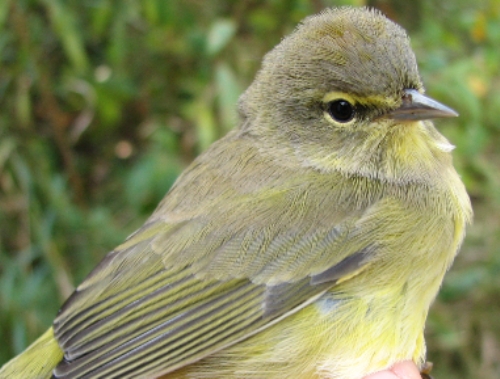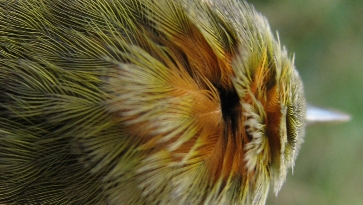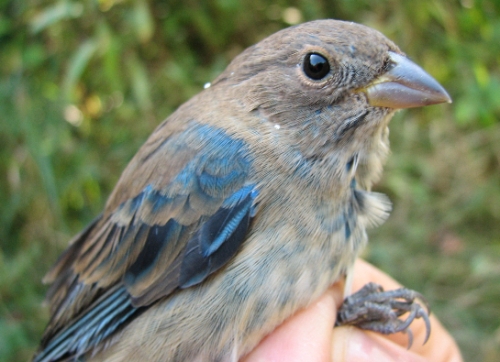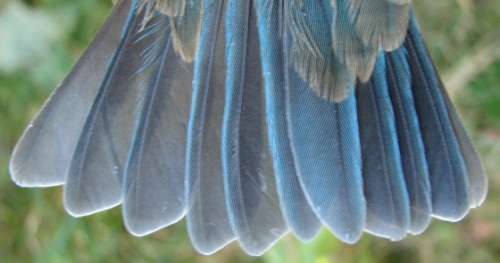|
Week 9: September 26 - October 2, 2008 |
Welcome
to the McGill Bird Observatory weekly report.
Click here for a complete listing of our archives.
Comments or
questions are welcome at "mbo AT migrationresearch.org".
|
PICTURE
OF THE WEEK: |
|

Orange-crowned Warblers may sometimes be confused with Tennessee Warblers, as
both have a similar greenish-olive colouration, but the yellowish eye-crescents of the
Orange-crowned Warbler are quite distinctive - and in the hand, the crown itself is often
visible too, as in the second photo below. Although common in western North America,
it is much less abundant in the east, with a dozen or fewer banded at MBO each year,
so it is always a welcome highlight when one stops in for a visit.
(Photo by Barbara Frei)
|
|
|
THIS WEEK |
THIS FALL |
2008 TOTAL |
SITE TOTAL |
|
# birds (and species) banded |
1113 (48) |
3016 (71) |
3858 (82) |
16836 (105) |
|
# birds (and species) repeat |
135 (14) |
564 (38) |
762 (43) |
2988 (64) |
|
# birds (and species) return |
-- |
23 (14) |
115 (22) |
446 (32) |
|
# species observed |
76 |
126 |
150 |
196 |
|
# net hours |
377.5 |
4163.8 |
7076.0 |
29021.8 |
|
# birds banded / 100 net hours |
294.8 |
72.4 |
54.6 |
58.0 |
|
|
Note: table does not include nocturnal banding (owls) |
|
Banders-in-charge: Barbara Frei, Marie-Anne Hudson, James Junda
Assistants: Jean Bacon, Jean-François Beauchemin, Katrina Belanger-Smith, Virginie Cabana-Vaudrin, Sophie Cauchon, Victoria Chang, Shawn Craik, Nicki Fleming, Tiffany Gamelin, Tiffany Gilchrist, Gay Gruner, Cristina Guillamette, Jeff Harrison, Marie-Mellissa Kalamaras, Genki Kendo, Kristen Keyes, Christie Lovat, Barbara MacDuff, Mike Mayerhofer, André Pelletier, Greg Rand, Brittney Roughan, Emilie Roy-Dufresne, Marylise Schmit, Cat Spina, Rodger Titman, Fredella Weil, Brigette Zacharczenko
Notes: If we would be bold enough to sum up this week in a single and eloquent word.... WOW!! Well, maybe not so eloquent - but week 9 of the 2008 fall migration season at MBO was a week during which we were repeatedly surprised at the records being broken. We suspected that one of our traditional ‘key species’, the Yellow-rumped or Myrtle Warbler, would show up in large numbers this year. They, like many other species, appear to have a 2-year cycle of highs and lows (in numbers) based on data at MBO over our first several seasons. Since 2006 was a high year (from what we could tell) for these ‘butter-butts’, we expected good numbers this fall, but nothing like we experienced this week - MBO was literally dripping with warblers! They absolutely stole the show, with the 729 yellow-rumps banded this week shattering (on their own) our previous high for the number of birds banded in a week, all species combined! Altogether, they accounted for 65% of the 1113 birds banded during week 9. For the first time in MBO's history, we banded over 200 birds in a day - and then we did so twice more before the week was over, despite missing a day due to rain, and reducing net hours on most other days to keep the volume of birds safely manageable!
Beyond the Yellow-rumped Warblers, there were other highlights at the station this week. Four species were banded this week for the first time this fall - Wood Thrush, Gray-cheeked Thrush, Orange-crowned Warbler, and Savannah Sparrow. Species observed for the first time this season included a flyover Greater Black-backed Gull and Rusty Blackbird.

A closeup of the Orange-crowned Warbler's head, showing where it gets its name.
(Photo by Barbara Frei)
|
Among the top ten species banded this week, Yellow-rumped Warblers of course won the top spot easily, with more than 4 times as many as were banded last week. Our other key species this week, Ruby-crowned Kinglets and White-throated Sparrows, were in second and third place respectively, and also doubled to quadrupled their numbers since last week. Last year there was also a good jump in White-throated Sparrows and a lesser one for Ruby-crowned Kinglets in week 9, but there were a mere 12 Yellow-rumped Warblers banded then. In fact, several times this week we banded more Yellow-rumped Warblers in one day than we did over the entire fall 2007 season (just 68 birds, reflecting the dramatic differences between highs and lows of this apparent cycle). Amidst all of the super-abundant birds, a pleasant surprise in the lower half of the list was the Blue-headed Vireo, which has only made the top 10 list once before ... in week 9 of 2006. Reflecting a pattern we've noted for several species this fall (including the Yellow-rumped Warbler this week), we banded almost as many Blue-headed Vireos this week as we ever have before in a full season! A couple of final species of note - the strong flight of Magnolia Warblers this fall is reflected by their continued presence in decent numbers at a time of year when we usually only see the last few stragglers, while the entry of the Slate-coloured Juncos at the bottom of the list is a sign that while migration is peaking, the later species are beginning to arrive, and we can expect a significant drop in diversity over the remaining four weeks of the season.
This week’s
top 10
[last week’s rank in brackets]
#
individuals banded |
mean # individuals observed daily |
1. Yellow-rumped Warbler (688) [1] |
1.
Canada Goose (310) [1] |
2.
Ruby-crowned Kinglet (111) [3] |
2.
American Crow (206) [2] |
3.
White-throated Sparrow (74) [2] |
3.
Yellow-rumped Warbler (155) [3] |
4.
Nashville Warbler (36) [4] |
4. American Robin (34) [8] |
5.
Song Sparrow (24) [6] |
5. Ruby-crowned Kinglet (33) [-] |
6.
Blue-headed Vireo (18) [-] |
6.
Red-winged Blackbird (32) [4] |
7. American Goldfinch (12) [-] |
7. White-throated Sparrow (27) [5] |
8. Magnolia Warbler (11) [7] |
8.
Common Grackle (27) [-] |
8.
Tennessee Warbler (11) [5] |
9.
Blue Jay (18) [6] |
10. Slate-coloured Junco (10) [-] |
10. Cedar Waxwing (17) [7] |
|
The ten most frequently observed species this week has changed little in comparison to week 8. Canada Goose and American Crow numbers have dropped, though they are both still secure in the top two spots. Conversely, Yellow-rumped Warblers have also maintained their position, but with a big spike in numbers, reflecting how omnipresent they were all around the site this week.

We could have photographed any number of Yellow-rumped Warblers for this space in the weekly report, but instead decided to focus on this colourful fellow. Although not as vivid as in its spring plumage, this after-hatch-year male still has splashes of blue, especially on his shoulder and tail.
(Photos by Barbara Frei)

|




